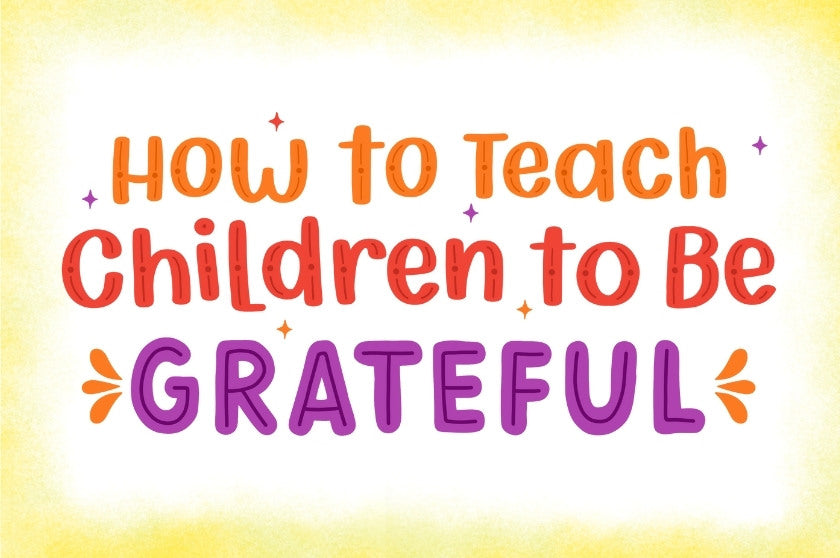
How to Teach Children to Be Grateful
Teaching children an attitude of gratitude requires helping them to look at their situations from a point of appreciation rather than from a deficit.
How do we, as parents or educators, teach children such an abstract skill?
We are here to help with TWO valuable resources:
- 21-Day Family Gratitude Challenge. Make this challenge a part of your night routine or family dinner time for the next 21 days (that's how long it takes to build a habit).
- 20 Ideas to Cultivate an Attitude of Gratitude in Children. This list of ideas you can start implementing today.

20 Ideas to Cultivate an Attitude of Gratitude in Your Children
Author: Shannon Lambert
1. Say please and thank you.
Our manners show that we do not believe we are entitled to anything and that in fact, we appreciate whatever comes our way.
2. Help someone less fortunate.
This could be your neighbor down the street, grandma, or someone you know who is in a tough spot.
3. Volunteer.
Help out at a homeless shelter, soup kitchen or non-profit.
4. Send out thank you cards.
Express your gratitude for those who have added value to your life.
5. Look for awe-inspiring moments in your day.
If the sunset is particularly beautiful, comment on it. If the sound of the baby’s laughter warms your heart, tell your children. Encourage them to look for their awe-inspiring moments and share them with you.
6. Share your gratitude at bedtime.
Take five minutes at the end of the day to ask your child what he is thankful for that day.
7. Share your gratitude at the dinner table.
Take a moment at dinner time to share what you are thankful for. Go around the table, allowing each family member a chance to vocalize their gratitude.
8. Compliment others.
Encourage your children to do the same. Share the things you appreciate about another person.
9. Keep a gratitude journal.
This can be in any form that works best for your child’s age, skill level and desire. Some children will want to spend time writing their thoughts down. Others may be more apt to express their gratitude through drawing or painting.
10. Write a letter.
Encourage your child to write a letter to someone who has touched his life in some way. If he is comfortable, make a visit to that person to read the letter out loud. If not, mail it.
11. Create a family gratitude list.
Post it on the fridge. Add to it when necessary.
12. Create a family gratitude journal.
Leave it somewhere where everyone can access it and encourage your family to write in it whenever they are feeling grateful.
13. Give someone a gift.
Help your child earn the money and purchase the gift. Or make a gift together.
14. Always look for the positive.
Find something positive in frustrating situations and discuss it.
15. Practice turning complaints into praises.
Coach your children to reword their complaints into something that they appreciate instead.
16. Create a gratitude jar.
Encourage your children to add to it anytime they are feeling grateful for something or someone.
17. Donate to a nonprofit.
Nonprofits serve people in need and at this time of the year, they are always looking for basic necessities, meals, and gifts to give to those in need.
18. Take gratitude walks.
While you walk, look for the simple pleasures in the day, such as the warm sun or the birds singing, and express appreciation for them. Use this time to ask your children what they are grateful for.
19. Ask why.
As your child gets better at expressing gratitude, dig deeper. Ask why he is grateful for something and how it affects his day.
20. Work through envy.
Help your child work through any feelings of jealousy she may have. Envy can come when we are not feeling thankful for what we have, and are focusing instead on what others have.
Gratitude is a skill. An attitude of gratitude is a positive way of looking at life. Gratitude can increase our children’s happiness, teach them to be more empathetic, and help them to be more thankful for everything they have.
Be sure to check out our Best Sellers Bundle PDF (ages 5-11). It includes our three most popular printable kits packed with science-based growth mindset activities, guides, and crafts for children. With over 50 pages, this kit will help your children or students understand they have the capacity to learn anything.


Please add me to your email list. :)
Thanks!
Thank you for the excellent teaching tool.
Thank you for the excellent tool.
This were some awesome reminders and simple ways to integrate mindful gratitude with our children. Thanks Can’t wait to use our printables!